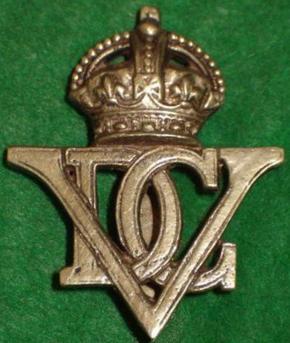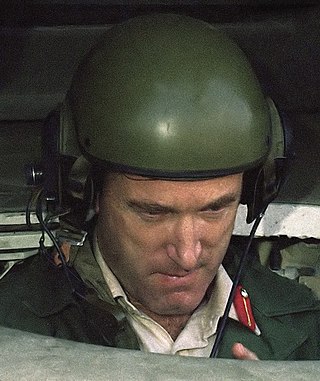
The Royal Dragoon Guards (RDG) is a cavalry regiment of the British Army. It was formed in 1992 by the amalgamation of two other regiments: The 4th/7th Royal Dragoon Guards and the 5th Royal Inniskilling Dragoon Guards. Based in Battlesbury Barracks, Wiltshire, the regiment currently serves as the armoured cavalry reconnaissance unit of 20th Armoured Brigade Combat Team. Previously equipped with the Scimitar armoured reconnaissance vehicle, it started converting to the Warrior tracked armoured vehicle in 2022.

The 5th Royal Inniskilling Dragoon Guards was a cavalry regiment of the British Army formed in 1922 by the amalgamation of the 5th Dragoon Guards and the 6th (Inniskilling) Dragoons. It served in the Second World War and the Korean War. In August 1992, as a consequence of the Options for Change defence cuts, the regiment was amalgamated with the 4th/7th Royal Dragoon Guards to form the Royal Dragoon Guards.

Major General Sir Simon Christie Cooper, is a retired British Army officer who served as Major-General commanding the Household Division and General Officer Commanding London District and later Master of the Household to the Sovereign.
Lieutenant-General Sir Richard Maurice Hilton Vickers is a former British Army officer who served as Director-General of Army Training from 1982 until 1983.

The 4th/7th Royal Dragoon Guards was a cavalry regiment of the British Army formed in 1922. It served in the Second World War. However following the reduction of forces at the end of the Cold War and proposals contained in the Options for Change paper, the regiment was amalgamated with the 5th Royal Inniskilling Dragoon Guards, to form the new Royal Dragoon Guards in 1992.

The 5th Dragoon Guards was a British army cavalry regiment, officially formed in January 1686 as Shrewsbury's Regiment of Horse. Following a number of name changes, it became the 5th Regiment of Dragoon Guards in 1804.

The 6th (Inniskilling) Dragoons was a cavalry regiment in the British Army, first raised in 1689 as Sir Albert Cunningham's Regiment of Dragoons. One of the regiment's most notable battles was the Battle of the Boyne in July 1690. It became the 6th (Inniskilling) Regiment of Dragoons in 1751. The regiment also fought with distinction in the Charge of the Union Brigade at the Battle of Waterloo and again as part of the successful Charge of the Heavy Brigade against superior numbers at the Battle of Balaclava during the Crimean War. The First World War sounded the death knell for mounted cavalry as it became apparent that technology had moved forward with greater destructive power and made horsed cavalry redundant on the modern battlefield. The British Army reorganised and reduced its cavalry corps by disbanding or amalgamating many of its famous cavalry regiments. The Inniskillings was one of those affected. It saw service for two centuries, including the First World War, before being amalgamated with 5th Dragoon Guards to form 5th/6th Dragoons in 1922.

General Sir Charles Frederic Keightley, was a senior British Army officer who served during and following the Second World War. After serving with distinction during the Second World War – becoming, in 1944, the youngest corps commander in the British Army – he had a distinguished postwar career and was the Governor of Gibraltar from 1958 to 1962.
Major General David John Rutherford-Jones is a retired British Army officer and former Commandant of the Royal Military Academy Sandhurst.

General Sir Cecil Hugh Blacker was a senior British Army officer and a former Adjutant-General to the Forces.
Major General Patrick Anthony John Cordingley, is a retired British Army officer who commanded the 2nd Division from 1995 to 1996.

General Sir John D'Arcy Anderson, was a British Army officer who reached high office in the 1960s.
Major-General Patrick Guy Brooking was a British Army officer who served as commandant of the British Sector in Berlin.

Major-General Roger Evans was a British Army officer who commanded the 1st Armoured Division during the early stages of the Second World War.

Colonel Sir Michael Picton Ansell, CBE, DSO was a soldier, show jumping rider, polo player, and horse show administrator.
Major-General William Andrew Evans is a former British Army officer.
Major-General Henry Gabriel Woods, was a British Army officer.

Major General Timothy David Hyams, is a senior British Army officer.











